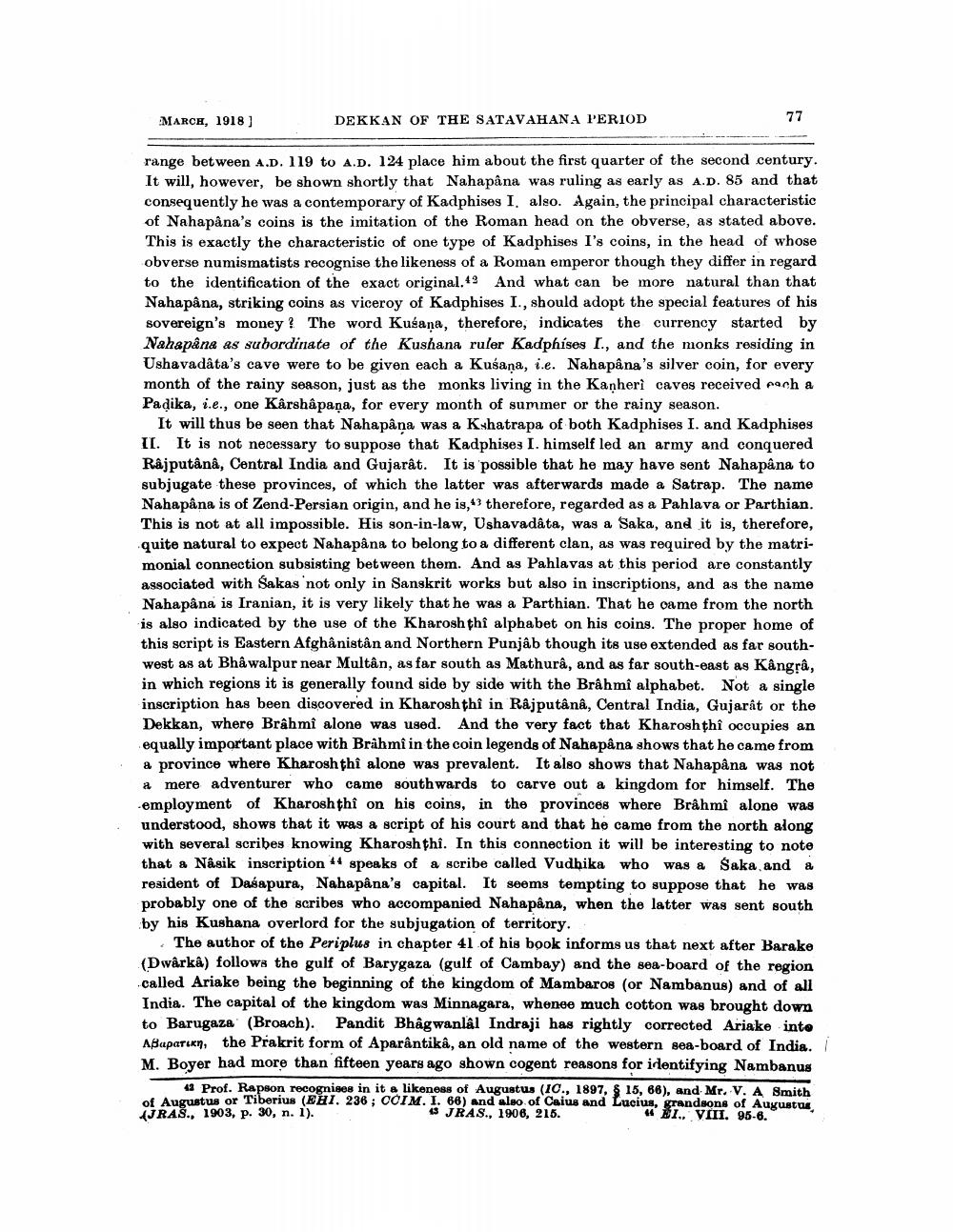________________
MARCH, 1918)
DEKKAN OF THE SATAVAHANA PERIOD
range between A.D. 119 to A.D. 124 place him about the first quarter of the second century. It will, however, be shown shortly that Nahapana was ruling as early as A.D. 85 and that consequently he was a contemporary of Kadphises I. also. Again, the principal characteristic of Nahapana's coins is the imitation of the Roman head on the obverse, as stated above. This is exactly the characteristic of one type of Kadphises I's coins, in the head of whose obverse numismatists recognise the likeness of a Roman emperor though they differ in regard to the identification of the exact original. 49 And what can be more natural than that Nahapana, striking coins as viceroy of Kadphises I., should adopt the special features of his sovereign's money? The word Kusana, therefore, indicates the currency started by Nahapå na as subordinate of the Kushana ruler Kadphíses I., and the monks residing in Ushavadåta's cave were to be given each a Kusaņa, i.e. Nahapana's silver coin, for every month of the rainy season, just as the monks living in the Kanheri caves received each a Padika, i.e., one Kârshâpaņa, for every month of summer or the rainy season.
It will thus be seen that Nahapana was a Kshatrapa of both Kadphises I. and Kadphises II. It is not necessary to suppose that Kadphises I. himself led an army and conquered Rajputânâ, Central India and Gujarât. It is possible that he may have sent Nahapana to subjugate these provinces, of which the latter was afterwards made a Satrap. The name Nahapana is of Zend-Persian origin, and he is,43 therefore, regarded as a Pahlava or Parthian. This is not at all impossible. His son-in-law, Ushavadata, was a Saka, and it is, therefore, quite natural to expect Nahapana to belong to a different clan, as was required by the matrimonial connection subsisting between them. And as Pahlavas at this period are constantly associated with Sakas not only in Sanskrit works but also in inscriptions, and as the name Nahapana is Iranian, it is very likely that he was a Parthian. That he came from the north is also indicated by the use of the Kharosh thî alphabet on his coins. The proper home of this script is Eastern Afghanistan and Northern Punjab though its use extended as far southwest as at Bhawalpur near Multân, as far south as Mathura, and as far south-east as Kângrâ, in which regions it is generally found side by side with the Brahmi alphabet. Not a single inscription has been discovered in Kharosh thi in Rajputânâ, Central India, Gujarat or the Dekkan, where Brahmi alone was used. And the very fact that Kharosh thî occupies an equally important place with Brahmi in the coin legends of Nahapana shows that he came from a province where Kharosh thi alone was prevalent. It also shows that Nahapâna was not a mere adventurer who came southwards to carve out a kingdom for himself. The employment of Kharosh thî on his coins, in the provinces where Brahmi alone was understood, shows that it was a script of his court and that he came from the north along with several scribes knowing Kharosh thi. In this connection it will be interesting to note that a Nâsik inscription 44 speaks of a scribe called Vudhika who was a Saka and a resident of Dasapura, Nahapana's capital. It seems tempting to suppose that he was probably one of the scribes who accompanied Nahapana, when the latter was sent south by his Kushana overlord for the subjugation of territory.
The author of the Periplus in chapter 41 of his book informs us that next after Barake (Dwarka) follows the gulf of Barygaza (gulf of Cambay) and the sea-board of the region called Ariake being the beginning of the kingdom of Mambaros (or Nambanus) and of all India. The capital of the kingdom was Minnagara, whenee much cotton was brought down to Barugaza (Broach). Pandit Bhâgwanlal Indraji has rightly corrected Ariake into ABapatun, the Prakrit form of Aparântikâ, an old name of the western sea-board of India. / M. Boyer had more than fifteen years ago shown cogent reasons for identifying Nambanus
43 Prof. Rapson recognises in it a likeness of Augustus (10., 1897, § 15, 66), and Mr. V. A Smith of Augustus or Tiberius (EHI. 236: OCIM. I. 66) and also of Caius and Lucius, grandsone of Augustus (JRAS., 1903, p. 30, n. 1).
15 JRAS., 1906, 215.
4 BI., VIII. 95-6.




